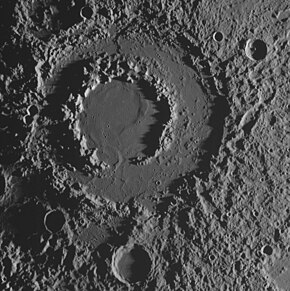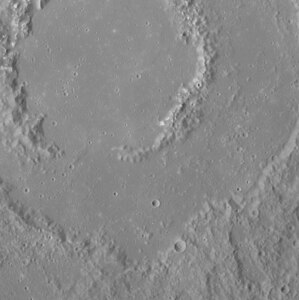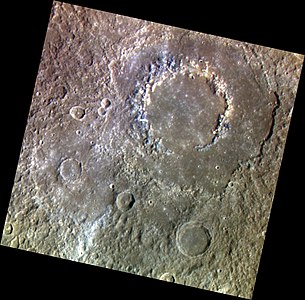Vivaldi (crater)
Appearance
 MESSENGER WAC | |
| Feature type | Peak-ring impact basin |
|---|---|
| Location | Beethoven quadrangle, Mercury |
| Coordinates | 13°46′N 85°55′W / 13.76°N 85.92°W |
| Diameter | 213.0 km (132.4 mi) |
| Eponym | Antonio Vivaldi |
Vivaldi is a crater on Mercury. It was named by the IAU after Italian composer Antonio Vivaldi in 1976.[1] It has a prominent and nearly continuous inner ring whose diameter measures about half that of the outer ring. It is one of 110 peak ring basins on Mercury.[2] Unlike some of the lunar multiringed structures, no vestiges of additional rings are apparent around this crater. It is classified as c3 age.[3]
A confirmed dark spot is present in along the northern peak ring.[4] This dark spot is associated with hollows.
-
Mariner 10 image from 1974
-
Vivaldi is the large, shadow-filled, double ringed crater to the upper right. From MESSENGER's first flyby in January 2008.
-
Interior of Vivaldi showing possible hollows on the peak ring.
-
Exaggerated color image
References
[edit]- ^ "Vivaldi". Gazetteer of Planetary Nomenclature. NASA. Retrieved 10 May 2022.
- ^ Chapman, C. R., Baker, D. M. H., Barnouin, O. S., Fassett, C. I., Marchie, S., Merline, W. J., Ostrach, L. R., Prockter, L. M., and Strom, R. G., 2018. Impact Cratering of Mercury. In Mercury: The View After MESSENGER edited by Sean C. Solomon, Larry R. Nittler, and Brian J. Anderson. Cambridge Planetary Science. Chapter 9.
- ^ King, John S.; David H. Scott (1990). "Geologic Map Of The Beethoven (H-7) Quadrangle Of Mercury" (PDF).
- ^ Zhiyong Xiao, Robert G. Strom, David T. Blewett, Paul K. Byrne, Sean C. Solomon, Scott L. Murchie, Ann L. Sprague, Deborah L. Domingue, Jörn Helbert, 2013. Dark spots on Mercury: A distinctive low-reflectance material and its relation to hollows. Journal of Geophysical Research Planets. doi.org/10.1002/jgre.20115




